- Gardening adventures, Natives, Other Insects, Permaculture and Edible Forest Gardening Adventures, Soil
Native Planting

Milkweed and wildflowers are host to butterflies, and the garden is still full of them. Today the forecast searing sun hid behind clouds all morning, making it a perfect Fall day for planting natives. The area all along the northern property fenceline is dedicated to plants found in our San Diego coastal sage scrub habitat. The dirt along this area is bad. It is sandy dirt over hard clay, a product of years of runoff flowing in from the neighbor’s yard.

The native California strip with dirt, not soil. Last year coastal live oaks, cork oak and Engelmann oak were planted along this strip, and little else. The soil was covered with sheaths of palm leaves, and they helped protect the soil and hold in some moisture, but there is little decomposition rate from them. The soil needed oak leaves.
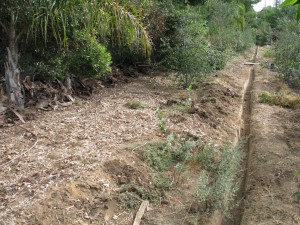
A coating of oak leaves will help fire the soil; more leaves will be coming soon. Last Monday Lori, a friend who is working here weekly did a tremendous job carefully raking back all the palm sheaths, then bagging oak leaves from the walkways around the massive old oak on the embankment and spreading them around between the new oaks. There are plenty of leaves left for the health of the big oak; just the leaves on the slippery stairs were moved. The oak leaves will decompose and provide the soil with the nutrients to host fungal action in the ground; the start of soil building.

Planting lemonade berry and sugarbush. Today Jacob and I planted a number of lemonade berry, sugarbush and deerweed, as well as two replacement coastal live oaks. I had purchased packets of seed mixes as well as several types of lupine (nitrogen fixer), making sure there was no alyssum, evening primrose or borage in the packets (they do very well on their own on the property!).
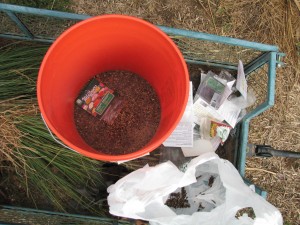
Take a lot of seed packets, empty them into a bucket, stir and voila! Diversity! I also took some seedheads from a couple of non-native sunflowers and threw them into the mix.
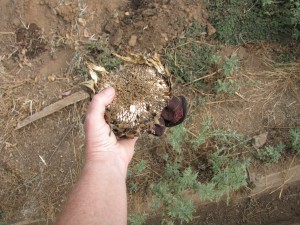
Breaking up a sunflower for seeds. In every damp spot from the subterranean irrigation we planted wildflower seeds.
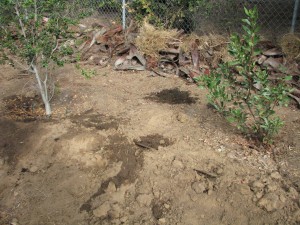
The subterranean irrigation leaves damp spots on the soil, where I plant flower seeds. They’ll choke out future weeds as well. We’ve had stunning results from this method for several seasons. It is the middle of October and there are still flowers blooming, providing beauty and food for insects and birds.
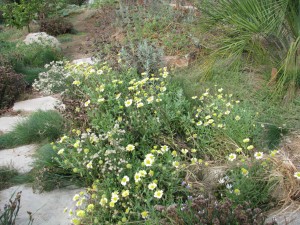
Stands of wildflowers feed the insects and look wonderful. Some herbs such as purple basil and parsley have come up late.

Purple basil showing up between the last of the squash vines. Either I use it or let it go to seed to feed insects and reseed itself. California poppies that have died off are showing new leaf growth around the base of the plants. So all-in-all a very successful day, thanks to the hard work of my helpers and the cooperation of the weather. These native plant guilds of plants, mulch and flowers will all work towards turning that soil alive and begin the communication between the native plants that will make this habitat for native animals priceless.
- Compost, Gardening adventures, Other Insects, Permaculture and Edible Forest Gardening Adventures, Soil, Worms
Compost Happens
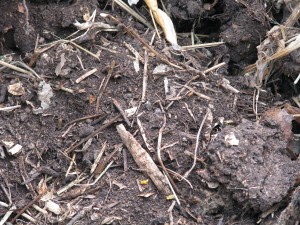
Good rich soil that needs screening Compost happens, whether you fool with it or not. Given moisture, air circulation and the creatures that help decompose and you can compost anything. Without these factors you have mummies. Or zombies, but that is another discussion. If you want to read about the many ways to compost without a heap, please read Fifty Ways to Leave Your Compost.
I am a lazy composter. When I weed I usually throw what I pull up under the growing trees to quickly mulch down. Excess weeds and branchy things I throw into a compost bin made of wire. Rats and mice enjoy the structures.
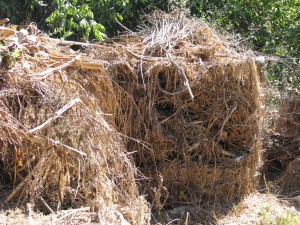
Wire bins of weeds have been gradually settling over the months. Kitchen scraps, paper towels, tissues, tea bags, paper cups and plates all go into a Rubbermaid compost bin I bought years ago. I don’t turn the piles. Compost happens, but it happens slowly. A little kitchen waste goes into another bin to feed sorely neglected worms.
I am also composting in place. A raised garden bed lined with wire to keep out gophers was empty, so I’ve been throwing in weeds and dirty chicken straw. By next spring it should be ready to use.

In this bed I’ve been composting in place. The Rubbermaid compost bin is in an inconvenient place. I’d moved it in early spring and now I’m moving it again. This doesn’t count as turning the pile, really, because the last time it sat in situ for years. It had the best soil under it on the whole property. Even without turning, and only over about six months, you can see that compost has been happening.
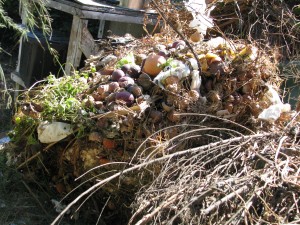
A lot of debris on top of the heap…. After I took the sides down, below the layer of debris there was about four inches of compost.
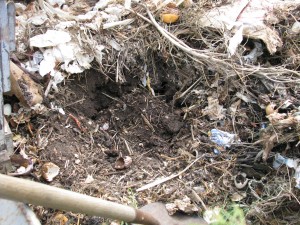
After about six months with no turning, there is great compost at the bottom This I screen and then use in the raised vegetable beds.
My garden’s demand for compost is more urgent these days, and the amount of debris to compost is larger. If I had a chipper or shredder, much of the debris would be composted in a short amount of time. However I’m going into the regular compost bin operation. I had a three-bin compost bin made out of old pallets. I already had the green metal stakes to hold up the pallets, and three pallets to use. Unfortunately they weren’t all the same shape or size, so the two wonderful men creating this for me, Jacob and Steve, went on a pallet hunt in their yards and came back with what was needed.
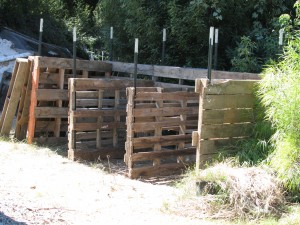
Wooden pallets make a great compost bin. Debris and yet-to-be-collected-from-a-friend’s-house llama poo will be layered in the first chamber and watered. As it decomposes it will be turned into the second bin, and the process begun again in the first. Then each will be moved again and all three chambers will be filled with compost in three degrees of decomposition. It should be easy to fill a wheelbarrow from the last chamber, screen it and deliver the rich compost to the base of the fruit trees and my raised veggie bed. Meanwhile, weeds that have recently been gathered, especially ‘trouble’ weeds such as Bermuda grass, are stuffed in black plastic sacks and cooking in the sun until they can’t reproduce anymore, and then will be added to the heaps. I don’t like using plastic, or contributing to the amount of plastic on the planet, but I am reusing and recylcing the bags.
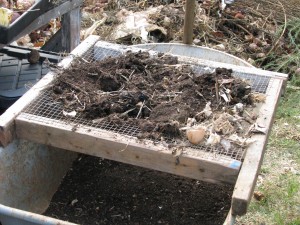
Screening compost twice, once with smaller holes. -
Protecting Fruit

Strange fruit. We have many young fruit trees, including three figs. We have a Black Mission, a white and a Strawberry Jam fig. The trees are a year in the ground and not quite head-height, but all produce small amounts of fruit which ripen sequentially.
The birds know about the figs.
I’m glad to share a percentage of my crops with wildlife; this is a habitat after all, and there is more than enough for me and for sharing. However, there aren’t a lot of figs to go around. My daughter while home from University this summer took on a competitive attitude when harvesting the figs. She was out early testing for perfect ripeness, testing again as the sun set, being foiled by pecked fruit when it was at its peak of perfection.
Netting trees is not a good idea. The netting sits on the trees and the birds sit on it and peck through. Meanwhile it snags and sticks on the trees and is almost impossible to remove without doing damage to the trees. Also that plastic or nylon netting, if left on the ground, will often be deadly to beneficial snakes which become entangled in it (read about how I released one here).

Miranda came up with a wonderful, easy solution that re-purposed something of which we had plenty: plastic berry baskets. These baskets were hard enough to form a space around the fruit so that a bird couldn’t get its beak down through it. They also allowed air to flow around the fruit and sunshine in to ripen. They were also incredibly easy to quickly twist-tie onto the branch around an almost-ripened fig, and reposition to the next fig when it was time to pick the first one. The long twist-ties often used to hold heads of lettuces together worked best. Extra baskets were handy to put the picked figs into as well. This solution could be used for small grape clusters as well.

Obviously this solution is for small trees; but then, when the tree is large it will be producing plenty of fruit to share with the birds. Or, we can get a ladder and a lot of berry baskets and twist-ties.
That, however, may just cause talk in the neighborhood.
- Animals, Bees, Birding, Gardening adventures, Other Insects, Permaculture and Edible Forest Gardening Adventures, Ponds, Reptiles and Amphibians, Soil, Worms
Fall Morning
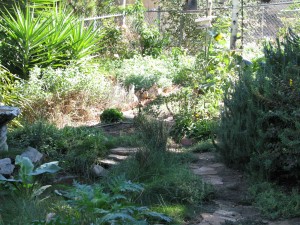
The birdwatching garden. I use the kitchen table as a work center, but spend a lot of time not working. That is because from the big dusty windowseat, through the spiderwebs that catch sunlight in the corners of the glass I watch a fairytale of animals. Song sparrows with their formal stripes and classy single black breast spot hop along the uneven flagstone walkway. The walkway, recently weeded, is again being compromised by sprouts. The small pond wears a heavy scarf of peppermint along its north side, and a mixture of fescues and waterplants around the south. A waterlily bravely floats pads on the still water after having been drastically thinned last month. A calla lily opens partially white, partially green.
Below the window in a dish of seed set low for ground feeders are house finches, the males’ proud red fading like the leaves of the Japanese maple behind the green bench. Lesser goldfinches skeletonize the leaves of sunflowers that have sprouted from birdseed; a nuthatch and a mountain chickadee take turns on the hanging suet feeder, both noisy and reminding me of pine forests. A pair of crows who have lived near this garden for years, but who have been about other business during the summer, are reunited on the telephone line. She grooms his feathers and he leans into her. I’ll have to put treats out for them, to keep on their good side. A Nutall’s woodpecker looks like a childhood toy by hopping straight up the big pine. I grin a welcome to a couple of white crowned sparrows, the forefront of the migratory flock. These spirited and chatty birds shuffle leaves onto my walkway every morning, and I quite happily sweep the leaves back for the next round. It is a ritual just between us. A young scrub jay swoops in with much show, seeing how big a reaction he can get from startling the smaller birds clustering at the feeders or taking warm dirtbaths. He lands on a small trellis and pecks out seeds from a sunflower I propped up after its yellow glory faded. Finches visit when he leaves and take their share of this high protein food.
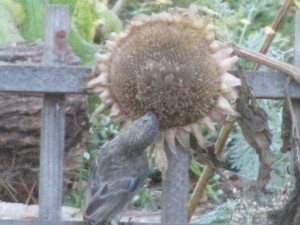
House finch nabbing sunflower seeds ( photo taken through a dirty window! Sorry!) The outside water is turned off; I should be on my knees in mud down by the chicken coop right now fixing a break in the pipe but I am held here by the autumnal light. Even in the morning it slants at a kinder angle, bringing out the gold in the leaves. Later when the water resumes the dripper on the bird bath will start and sparrows, finches, towhees and random visitors will sip drinks and take cleansing baths. One of my favorite sights is watching a group of finches taking turns in the bath, daring each other to stay longer and become wetter. Their splashing sends a cascade of drops into the sunlight. They give Finch Frolic its name. Now the only visitors are honeybees taking water to hydrate their honey. I emphathize with these bees. Only the older females do the pollen gathering, carrying heavy loads in their leg sacks back to the hive until they die in flight. A useful life, but a strenuous and unimaginative one.
Perhaps today there will also be a house sparrow, or a common yellowthroat or a disagreeable California towhee, what everyone knows as a ’round headed brown bird’. Or maybe the mockingbird will revisit the pyracantha berries, staking them out as his territory while finches steal them behind his back. I hear the wrentit’s bouncey-ball call, but as they can throw their voices I usually don’t spot them. Annas hummingbirds spend all their energy guarding the feeders, stopping to peer into the window to see if I’m a threat. My black cat Rosie O’Grady stares back, slowly hunching, mouth twitching with a soft kecking sound as if she could hunt through a window. I see that the hanging tray of grape jelly needs to be taken in and washed because the orioles have all migrated. Rosie is given up by the hummingbird and instead she watches cat TV as the birds shuffle in the Mexican primrose below the window.
I don’t see either of the bunnies this morning, Primrose or Clover. They live under the rosemary bush, and perhaps in the large pile of compost in the corner of the yard. I’ve watched them nibble the invasive Bermuda grass, and pull down stalks of weedy sow thistle and eat the flowers and seeds. They do no harm here, and are helping with the weeding; I love watching them lope around the pathways living in cautious peace.
Unseen by me by where I sit, mosquito fish, aquatic snails, dragonfly larvae, strange worms and small Pacific chorus frogs hang out in the pond and under the overhanging lips of flagstone I placed there just for them. Under the plants are Western fence lizards big and small awaiting warmth from the sun to heat up the rocks so they may climb the highest stone in their territory and posture while the heat quickens their blood. A mouse scurries between plants, capturing bits of birdseed scattered by the messy sparrows. The soil is good here, full of worms and microbes and fungus. Everything is full of life, if you only know how to look for it. You can smell it. You can feel it.
Now comes the spotted towhee, black headed with white patterns on his wings and reddish sides. Once called the rufous-sided towhee, he is bold and handsome, his call a long brash too-weeet. He sassily zig-zags down the narrow flagstone pathway looking for bugs.
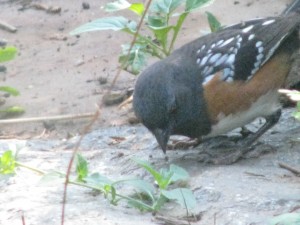
Spotted Towhee grubbing in his fancy clothes, so bright after a molt. I haven’t seen the rat family for a few days. The four youngsters invade the hanging feeders, tossing each other off and being juvenile delinquents. At night I hear the screech of a barn owl, which might be my answer.
The oxblood lilies – always a surprise during the dry and the heat of September, have almost all faded, but sprouts of paper white narcissus are beginning to break ground. They are Fall flowers here, usually done by Thanksgiving.
It is Fall. Finally. The world of my garden is tired and ready for a rest from the heat, the mating, the child rearing, the dryness, the search for diminishing food, the hiding so as not to become food. Although the days here are still in the high 80’s the evenings bring coolness and a much-needed dampness. Rain won’t come until November or later. But we wait for it, the animals, the plants and I. And time passes as I sit at the table and watch. I know of no better way to spend an autumn morning.
-
Jujube: a wonder tree

A handsome fruit. We mostly know the word jujube from having snacks as a kid in the movie theatre. Jujubes were once unchewable resinous candies of many flavors, and then were changed to something akin to gummy bears. Jujubes are a general term for a variety of candies in many countries. Oddly enough, and for reasons I know not, there is a tree called a jujube that bears wonderful fruit.

Jujube tree with fruit (a drupe, actually) ready to pick. Jujube trees (Ziziphus jujuba) have been cultivated in China for over four thousand years, and are gradually catching on in other countries. The first jujube fruit I ate was last year in a dried form. It was good, faintly reminiscent of a date. Now I have a tree that has just begun to bear fruit, and I am in love with it. The fruit is small, like very large olives. They begin green and then quickly turn to a reddish brown color, usually in blotches of color.

The fruit turns brown in patches, but can be eaten before completely dark. You can eat them fresh; in fact, I haven’t had them cooked yet. They are delightful. There is a center stone, such as in a date, but it holds two seeds.

Thin skin, crisp flesh like a green apple with a hint of date. The skin is thin and tender. The flesh is crisp and reminiscent of a green apple with hints of date. I love them. Many wait until the skin begins to wrinkle to eat them. You may pick the jujubes as they start turning color and they ripen quickly in the house without loss of flavor, or let them dry on the tree. Jujubes are high in vitamin C, and have been used medicinally in other countries, especially as a tea for sore throat. Best of all, so far the local birds ignore them, and there don’t seem to be any insect pests that love them.

Jujubes are a lovely reddish brown when ripe, and darken as they wrinkle. What makes the jujube a wonder tree is that it doesn’t seem to mind intense heat; in fact, it loves full sunshine and dry conditions. It also can survive a chill factor down to -28 degrees F! It doesn’t mind clay or alkaline soils, although good drainage and regular watering insures a good crop. They require little or no fertilization. There are many cultivars, the best being from China and more inferior ones from India and Japan. Many are thorny but some are virtually thornless. The trees can grow 30 feet high, have an attractive drooping appearance and are deciduous, the leaves yellowing before dropping. Suckers can appear several feet away from the trunk and can be controlled by mowing or pruning. You can read more about this remarkable tree here.
Why not try a jujube tree? They provide food, windbreak, mulch and have a very hard wood, and take just about any conditions. And the next time you go to a movie theatre you can bring your own jujubes… dried!
- Compost, Gardening adventures, Permaculture and Edible Forest Gardening Adventures, Rain Catching, Soil, Worms
Why Plant Natives?
The following article was written for and published in the summer 2012 Fallbrook Land Conservancy’s newsletter, the Conservation Chronicle (http://www.fallbrooklandconservancy.org/News/Chronicles/Summer2012/Summer2012.pdf, pg. 6). It was slightly edited and retitled for publication.
Why is planting native vegetation a good idea? We all know that native plants arranged in natural combinations and densities provide safety corridors for our native animals. San Diego’s plant communities have, like all established ecosystems, developed a symbiotic relationship with native and migratory fauna. Our plants leaf out, bloom and fruit when native animals and insects need the food, and provide appropriate nutrition that imported or invasive plants may not. Wildlife then disperses seed and pollen in methods that suit the plants, as well as providing the fertilizer for which the plants have adapted. Flora and fauna have set up symbiotic relationships to an extent where some species rely solely on a single other species for their existence. A balanced ecosystem is a dance between inhabitants who know each other’s needs and satisfy them for their own survival.
We plant natives in our yards because they are hard-wired for our soil and climate. They naturally conserve water and do not need fertilizer or insect control. They also can be beautiful. Planting native plants is good for our wallet, our resources and our health. But there is more to the equation. Living in every handful of good soil are billions of microscopic creatures and fungi collectively called microbes that make nutrients available to plant roots. The smell of fresh soil is a chemical released by these microbes called geosmin. Scientists now know that the microbes in undisturbed soils form a communication network between tree and plant roots. When a tree is attacked by insects, communication is sent out chemically by the tree’s roots and carried via this microbial network throughout the ecosystem, and other trees set up defense mechanisms to lessen their own damage.
Plants also communicate via scents not detectable by humans. Lima beans and corn planted downwind of brother plants which had been subjected to grasshopper attack lowered their sugar content to be less desirable. Such plants received 90% less insect damage than those planted upwind. California sagebrush (Artemisia californica) allows sibling plants to grow nearby because when attacked, it emits an airborne chemical to repel insects. The more sagebrush in the area, the better the protection as other sages respond in kind. Some plants when attacked will release a chemical that attracts the predatory insect which will feed upon the bug that is attacking the plant.
Thus plants communicate via airborne chemicals and through their roots via the microbial network. They call for help, they send out alarms and insect invitations and what’s more, they respond to each other. The why of planting natives is therefore also this: It is important to plant natives because they all speak the same language. Plants introduced to an area by humans are like strangers in a strange land. They cannot communicate well with other plants. They don’t know which bugs are bad until it’s too late. They have no one to call for help; the pheromones they emit are for beneficial bugs that live far away. Their seeds cannot supply the proper nutrition for the wildlife, and the wildlife may not be able to supply the plant with what it needs to keep healthy. They struggle to succeed in our soils and become stressed and sickly. We pour fertilizer and pesticides on them to help them survive, which kills the microbes that create good soil. Also, without the natural checks and balances found at the plant’s native ecosystem it may well become invasive and rob space, water and nutrition from our natives. The weeds you see in reclaimed properties are mostly non-native. Foxtails and wild radish do not belong here. Hike in some of the preserves which have not been previously farmed. There you’ll see the real native wildflowers, such as California peony, rattlesnake weed, tidy tips and Blue-Eyed Mary, living in harsh decomposed granite soils on little water, in relationships with the other chaparral surrounding them. You’ll understand a little more about how plants form guilds to support each other, and create that wholesome rightness that we feel when we walk in undisturbed nature. Recreating those guilds in your garden, adapted to provide human food, medicine and building materials, is called Permaculture.
-
When Is Tuna Fish Not Tuna Fish?
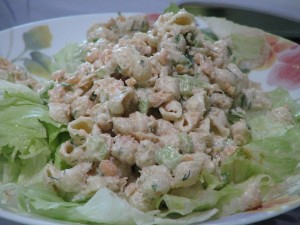
No-kill “tuna” salad! Prior to being a vegetarian, many years ago, I did enjoy a tuna sandwich or salad now and then. A perfect dish for a hot afternoon. During my almost twenty years of vegetarianism I’ve sampled many tuna substitutes, with various results. Most of them were discontinued, or were imported to a store on the East coast and then resold and shipped. Have you ever noticed how foods that are marketed as substitutes for other foods either have quotations around their names as if someone was whispering it behind their hand? Or else the names are spelled wrong, like Tuno or Bakon. There is also the saner although still questionable method of placing the word ‘mock’ in front of the word, such as ‘mock-tuna’, which is better than misspelling. Anyway, back to the topic, in trying to keep my carbon footprint low I’m eliminating the purchase of goods that require so much shipping.
This week I discovered a marvelous tuna substitute (I say, “discovered” when really I’m probably the last to know). It is low calorie, high in protein and fiber, inexpensive, easy to prepare, doesn’t kill tuna or dolphins, and they grow here in California. I can also buy them organic. They are garbanzo beans, otherwise known as chickpeas.
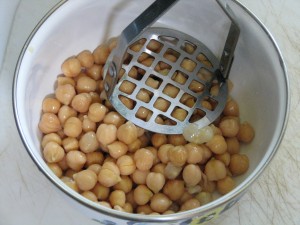
Mash garbanzos (what a great name for a bean!) until they are almost smooth. The flavor of garbanzo beans is very mild and takes well to light seasoning. Substitute mashed garbanzo beans in your favorite tuna salad or sandwich recipe. If you use Veganase – a dairy-free mayonnaise substitute – then you have a mock tuna salad or sandwich that won’t be dangerous to eat at picnics because neither the beans nor Veganase spoil quickly. Incorporating dill into the mix gives the mix a fishier flavor, since dill is so commonly paired with fish. Simple, nutritious, inexpensive and very yummy. Can’t go wrong with that!
Mock Tuna SaladAuthor: Diane C. KennedyRecipe type: EntreePrep time:Total time:Serves: 2-4A high-protein and fiber, low-cost tasty tuna substitute without any trace of mercury or dolphin!Ingredients- One can organic garbanzo beans
- 2-3 tablespoons Veganase or mayonnaise
- 1 teaspoon minced dill, preferably fresh
- 2 stalks celery, chopped
- 2 -3 cups cooked, cooled small shaped pasta, such as shells
- ¼ teaspoon ground cumin
- Salt and pepper to taste
- Chilled iceberg lettuce
Instructions- Drain and empty canned garbanzos into a small bowl.
- Mash with a potato masher until almost smooth, keeping some of the lumps for texture.
- Stir in Veganase, dill, celery, cumin, salt and pepper.
- Stir chickpea mixture into cooled noodles until well mixed.
- Serve over iceberg lettuce with a dill pickle on the side.
-
Caramel Ganache Shortbread Bars
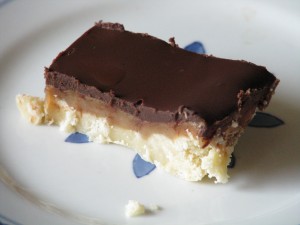 Just because I don’t post as often as I ought to, doesn’t mean that I’m not always preparing for posts. I take lots of photos, look up lots of data and try lots of recipes. Many recipes are researched, tweaked, photographed, made and turn out… icky. For instance, the no-bake cookies of last week that were only firm enough to cut at refrigerator temperature. At room temperature they turned into a pan of chocolate sludge, and at freezer temperatures they were too hard to cut. I have found, to my dismay, that many food bloggers post recipes even if they don’t turn out well, just so that they have something to post. I’m learning to read and heed the disclaimers.
Just because I don’t post as often as I ought to, doesn’t mean that I’m not always preparing for posts. I take lots of photos, look up lots of data and try lots of recipes. Many recipes are researched, tweaked, photographed, made and turn out… icky. For instance, the no-bake cookies of last week that were only firm enough to cut at refrigerator temperature. At room temperature they turned into a pan of chocolate sludge, and at freezer temperatures they were too hard to cut. I have found, to my dismay, that many food bloggers post recipes even if they don’t turn out well, just so that they have something to post. I’m learning to read and heed the disclaimers.The recipe I’m about to impart to you is not a fluke. It is, frankly, heavenly.
At a baby shower a few months ago I ate a bar cookie that was supposed to taste like a Twix candy bar. It was very good with its layers of shortbread, caramel and chocolate. I asked for the recipe and reproduced it at home. The recipe called for crushed pre-made cookies (the Keebler elves had made them, apparently) topped with melted caramel candies (unwrapping all those little buggers took time), and spread with melted milk chocolate chips. The result was tasty, but I couldn’t get over the store-bought flavor of the shortbread. This cookie has three simple flavors that need to complement each other, and since I don’t usually eat store-bought baked goods, it took some adjustment for my palate. However, they froze very well and defrosted quickly.
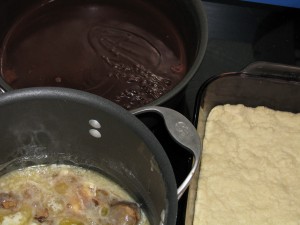
Ganache, baked shortbread and caramel mixture beginning to boil. Then I found a better recipe. And then I made it perfect. It is a basic shortbread cookie crust, topped with a simple homemade caramel, then topped with chocolate ganache. The driving impetus for this improvement was that I had leftover heavy cream in the fridge from making homemade ice cream, and needed to use it before it went bad. The ganache topping adds a bright, lighter flavor which keeps the cookie from being cloying. Yum.
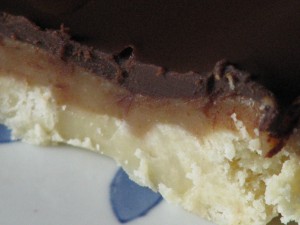
Eat a small piece with some hot tea and be very, very happy.
Caramel Ganache Shortbread BarsAuthor: Diane C. KennedyRecipe type: DessertPrep time:Cook time:Total time:Serves: 16Chocolate ganache atop firm homemade caramel and buttery shortbread. What else is there to say besides it is quick and easier than you may think.Ingredients- For shortbread:
- ⅔ cup butter, softened
- ¼ cup granulated sugar
- 1¼ cups all-purpose flour
- For ganache:
- 1 cup heavy cream
- 4 tablespoons unsalted butter
- 8 oz. semi-sweet or milk chocolate, in small pieces
- For caramel:
- ½ cup unsalted butter
- ½ cup packed light brown sugar
- 2 tablespoons light corn syrup
- ½ cup sweetened condensed milk
Instructions- Preheat oven to 350 degrees F.
- In a medium-sized bowl, mix together the ⅔ cup butter, granulated sugar and flour until crumbly.
- Press the sandy shortbread mixture into a 9-inch square baking pan.
- Bake for 20 minutes or until shortbread begins to lightly brown around edges.
- Meanwhile make the ganache. In a small saucepan combine heavy cream and 4 tablespoons butter.
- Bring mixture to a simmer.
- Turn off heat and add chocolate, swirling to cover all the bits.
- Cover pan and let sit for about 5 minutes until chocolate is melted.
- Stir until smooth and creamy and set aside (don't refrigerate).
- In a 2-quart saucepan, combine ½ cup butter, brown sugar, corn syrup and sweetened condensed milk.
- Bring to a boil and continue to boil for five minutes.
- Remove from heat and beat quickly with a wooden spoon for about 3 minutes.
- Pour caramel over baked crust (warm or cold).
- Cool until caramel begins to firm, or chill.
- Pour ganache evenly over firm caramel.
- Cover dish with plastic wrap and chill completely in refrigerator until very firm.
-
Keep In Your Pets: It is Predator Season
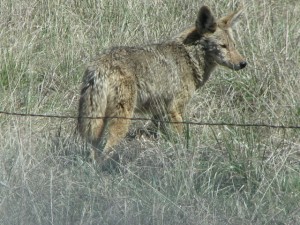
This juvenile coyote was playing with his litter mate at the Santa Rosa Preserve in plain site of the road. Youth just aren’t cautious, no matter what species. Photo by Miranda Kennedy We are entering the time of year when outdoor cats, small dogs, free-range chickens and any small pet go missing. Pre-adult (aka teenage) coyotes from this year’s early litters are just as hungry and just as fearless as human teens, and they are looking to fill growling stomachs during the day and night. (Besides, a study by University of Nebraska found that feral cats are responsible for the extinction of 33 species of birds worldwide. Keep your cats contained!) Can’t blame coyotes because this is their land. Preditors are an important part of our ecosystems and the removal of them have devastating effects on our ecosystems, all the way down to the plants in a process called trophic cascade. During this heat wave I’ve been sleeping with windows open. At about 5:15 am I heard the hens going crazy down in their Fowl Fortress . Throwing on my white robe and slippers I ran down the hill towards the coop. Just before I reached it, a young handsome coyote came around the corner behind the compost bins and we nearly collided. He was across the property and over the chain link fence in a heartbeat. The hens were safe because the Fortress is wired up both sides and across the top, and the wire goes into the dirt. However if the coyote were to have time to dig he could have been inside. The hens were so upset that they didn’t lay right for several days. Miss Amelia, the leader, was on top of the chicken tractor screeching away. Chickpea and even formidably-built Lark were on top of the smaller coop. These three survived the coyote attack that killed two of their friends last winter (pre-Fowl Fortress). The two adopted Rhode Island Reds were standing by the door wondering what all the fuss was about; they’ve seen our two elderly, partially deaf and blind dogs walk past all the time. General Mischief, whose probably only working park is his sniffer, lumbered excitedly around the property following the coyote’s path. At night I began to lock the hens inside the chicken tractor where they roost inside the Fortress, so that they’d have two lines of defense.
The next morning I arose to chicken screeching even earlier, and ran down there to see a coyote coming from around the back of the Fortress. I knew where it would jump the fence so I ran in that direction, which gave it quite a surprise as it had to pass me to get there. I stood at the fenceline brandishing a rake that I had caught up on the way down the hill, dressed in slippers and long white robe, shouting threats into the neighbor’s backyard like a lunitic. One thing about growing older is that eccentric behavior is excused.
I wasn’t about to let the coyotes believe they could hunt within my fence. The next morning I was up and out just after five, me and General, my rake and my white robe, over which I’d pulled a red jacket because the morning was misty. I stood at the fenceline, pulling some ragweed to not waste time. In about five minutes I felt that they were coming and stood waiting. Sure enough, halfway across the neighbor’s property were some bushes and from around behind them trotted a coyote. He looked pretty jaunty and sure of himself until he turned and caught an eyeful of me. I shook my rake and he seemed to shake his head disbelievingly. Then he cut out the way he had come. Victory for me!
I collected dog poo and dumped it along the fenceline, and stuck clumps of fur left from shaving General’s thick coat into the top holes in the fence. I love the country life.
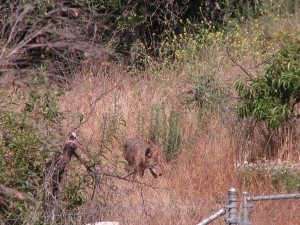
Of course I didn’t bring a camera on my morning patrols. This coyote was in what is now the Bee Garden, several years ago. He looks worse for wear. Photo by Miranda Kennedy. For the next few mornings I’d roll out of bed, motivate Sophie and General to get up and go outside, and I’d patrol the fence and make my presence known at the entry point. Although I was sleep-deprived (with the late darkness I tend to only get dinner at about 9 and to bed by 11) I managed to to get some impressive gardening done, especially since I changed into old clothes before heading out. There was no more coyote activity, at least none that the hens told me about.
The other night the pack was running down in the streambed and were yipping and howling in communication. I think it was just past midnight, but I went out there just to make sure there were no visitors.
Sophie is a 14 year old rescued pit bull mix I’ve had since she was about a year old. I knew that she had run with coyotes as a youngster when her owner let her loose, and I never understood why she hadn’t been attacked. Her back legs don’t work well, and she’s feeling her age. She used to climb the chain link fence and roam the neighborhood. She used to kill cats, chase rabbits, keep the mice and rats out of the garage where they used to sleep. For the last few years it has been all peace and love with Sophie. She not only seems to be afraid of some of the cats in the house, but would walk past the ranging hens without putting any of her thoughts into action. I once went to wake her up when she was still sleeping outside, and a mouse ran out from under her. I’d disturbed its warm cozy sleep.
So this morning I let out the dogs when General woke me up and tried to go back to bed. It never works because when General is done he rakes the metal security door with his nails until I let him in again. Sure enough, in about five minutes he was demanding attention again so I put on my robe and went out to do the hens. I was just past the driveway when I caught sight of Sophie on one of the garden paths close to the house. She had a friend with her. A coyote. Sophie was just turning away from it to walk back to the house and the coyote was looking around at the bushes, hopeful for a rabbit breakfast until it saw me and scooted away. The fur was raised a little on Sophie’s back, but not all the way. I made sure he was clear of the property, and checked the hens who were still double locked in. Then I had a few words with Sophie about the choice of friends she asked over!
-
Two Sure-fire Zucchini Recipes
Zucchini plants are like cats: They both look harmless when small, so you think the more the merrier. One plant is always enough, but it is hard to plant just one seed in case it doesn’t come up. Then the sprouts are hard to thin.. what if something eats it? Then before you know it, there are five enormous plants growing giant green clubs in the dead of night, just after you’ve checked all the plants. Well, that’s my situation anyway. Too many cats; too many zucchinis. When there are enough all at one time, we’re taking them (the zucchinis, not the cats) to the Fallbrook Food Pantry along with pumpkins and tomatoes. Until then, we’re exploring new ways to eat them. And I refuse to sully cheesecake with zucchini! (yes, there is such a recipe!).
My son who is studying Culinary Arts at the University of Hawaii sent me a link to smittenkitchen.com with an exceptional zucchini pancake recipe… not sweet, very light and completely tasty. I’ll include my version. But first I want to explain my ‘discovery’, which everyone but me probably knows about anyway.
SAUTEED ZUCCHINI
I had grated zucchini for bread and had some left over. It was dinnertime and I was alone, so I experimented. I heated a skillet with a little olive oil in it, threw in the grated, undrained zucchini, and stirred it around on medium-high heat for about five minutes. When it was beginning to wilt and brown a little on the bottom, I sprinkled sesame oil on it lightly, and then gave it a touch of Bragg’s Amino Acids, which I use for many things. A light soy sauce may substitute, but Bragg’s is high in nutrition, low in salt and a wonderful flavoring. Buy it online or in health food stores. The zucchini came out tasty and with a mouth-feel of wet wide noodles. It was fantastic. I’ve since made it for my daughter a couple of times, and each time we wanted more! Imagine that! On the plus side, it used up a medium zucchini.
You really must give these pancakes a try.
Fabulous Zucchini PancakesAuthor: Diane C. Kennedy (adapted from smittenkitchen.com)Recipe type: BreakfastPrep time:Cook time:Total time:Serves: 4A light, flavorful, really good pancake that uses up a lot of zucchini and tastes like zucchini bread.Ingredients- 2 large eggs
- 3 tablespoons olive oil
- 2 tablespoons sugar (optional)
- ¼ cup buttermilk or soured milk
- ½ teaspoon vanilla extract
- 2 cups shredded zucchini
- 1 cup all-purpose flour
- ¼ teaspoon table salt
- 1 teaspoon baking soda
- 1 teaspoon ground cinnamon
- ⅛ teaspoon ground or freshly grated nutmeg
- ¼ cup semi-sweet chocolate chips (optional)
- Oil, for coating skillet
Instructions- In a large bowl whisk eggs, olive oil, sugar, buttermilk and vanilla until smooth.
- Stir in zucchini.
- In a smaller bowl, combine flour, salt, baking soda, cinnamon and nutmeg.
- Stir dry ingredients into zucchini batter, mixing until just combined.
- Stir in chocolate chips.
- Heat oil or butter in a large, heavy skillet over medium heat.
- Scoop ¼-cup rounds of batter in pan so they do not touch.
- Cook until bubbles appear on the surface, about 2 to 3 minutes.
- Flip pancakes and cook another minute or two.
- Keep pancakes warm in on a tray in the oven set on low or in a toaster oven.
- Repeat with remaining batter.
- Serve warm with or without traditional pancake toppings.
- Pancakes freeze well.
